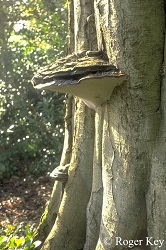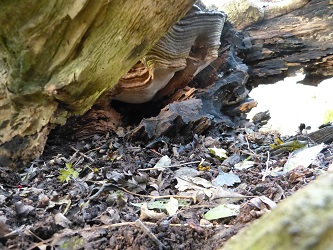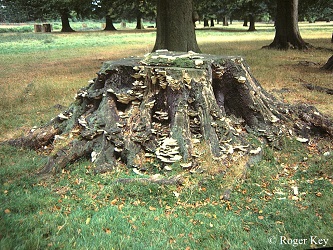Current ISIS code: A213
Previous assemblage name: A2 wood decay
Linked assemblage: Often in association with the other saproxylic assemblages A211 heartwood decay, and A212 bark & sapwood decay.
Description of habitat typically supporting the assemblage: This assemblage type is mainly characterised by beetles, with a few limoniid craneflies and platypezid flies. In reality, there are many more diptera associated with this assemblage, which are hand coded but not part of the original assemblage ordination.
The assemblage type is found in and around trees and shrubs generally, but especially in older specimens. A large variety of wood-decay fungi are active in all types of woody tissues from heartwood through to twigs and roots. All produce fruiting bodies on the outside of the decaying wood and above ground, which are exploited by this assemblage type.

Many species feed primarily on the fungal spores while others burrow into the fruit body itself. Some species specialise in the fruit bodies of particular fungal taxa, but the majority are generalists. The soft gill fungi in particular support a wide variety of invertebrates, while the tougher and woodier fruit bodies host a more specialist fauna.

Living trees and shrubs are important for this assemblage type, as they have the potential to continually produce fresh dead wood for fungi to break down, whereas dead trees provide more finite fungal habitat. Wood-decay fungi and their invertebrates are generally not host-specific, so exotic tree species can be as important as native ones.

Sites with the fullest expression of the assemblage are however historic sites with concentrations of mature and older trees and so ancient wood pasture - and ancient woodland situations generally - are the most important.
Many species of fungi fruit most prolifically in open sunny conditions, although others fruit in shade. Canopy density can therefore be an important factor.
Potentially important environmental impacts
- Removal of old trees and deadwood for health and safety, “tidiness” and “forest hygiene”.
- Loss of grazing leading to the smothering of older trees by secondary growth.
Sampling & assessing the assemblage
Standard sampling protocols apply, though sweeping time should be increased; it is likely that several visits, possibly coupled with pitfall grids will be necessary to gain enough species to make any assessment worthwhile.
Target groups: Coleoptera
Fieldwork methods: Beating & targeted search, through inspection.
Alternative methods: Sweep netting if considering the diptera more. Vane traps do record part of this fauna if well positioned, though is perhaps a secondary technique here.
Season: High summer & autumn.
Rearing from fungal fruiting bodies can give particular ecological insights, especially if the fungal host for the larvae can be identified. High summer visits can capture the earlier summer fruiting brackets such as Laetiporus spp, whilst the Autumn, hits fruiting of Fistulina hepatica and others. Health issues of pooting from fungi need to be considered.
Discrimination of conservation quality: good
Default target: 8 species
